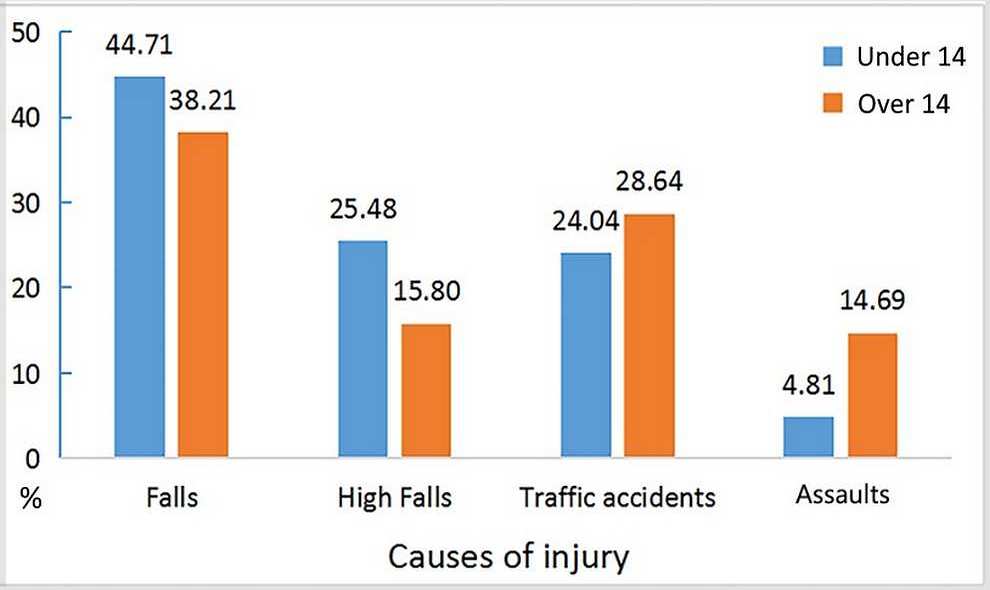
Who Suffers From Facial Trauma?
The answer to our question is of course that everyone can experience facial trauma, regardless of age, gender, or location but there are known patterns.
The chart above is from a detailed study on the incidence of maxillofacial injury in China although in broad terms, there were similarities with most regions.
Traffic accidents are often suggested as a prime cause and are significant but falls are the number one cause of facial injury in most countries, including Europe and the US.
In parts of North Africa and the Middle East, conflict, or terrorism have been a leading cause. Sports injuries can be notable in places and traffic injury levels vary, depending on the extent of enforced safety legislation.
The leading contribution made by falls is still clear across much of the globe, as are several other aspects.
Evident Patterns
A high incidence amongst the 6 to 11 age group in the Chinese study is repeated in most places. An age when children are becoming more independent but have not yet developed too much safety awareness.
Gender is consistently significant, with males 2 to 3 times more likely to suffer from maxillofacial injuries almost everywhere. An area of divergence is the levels of injuries seen at different adult ages.
In most of the world, there is a spike in injury rates at around 21 to 28 years old. This includes places where violent trauma is less likely to be a cause, in most countries, falls lead this age group.
According to data from the Global Burden of Disease Study, relative incidence only catches up in those over 80, if at all. The way older people are treated, or regarded in varying societies makes a difference.
In general, the belief that fall injuries increase with age is not supported by the data. At advanced ages this may be true but bearing in mind the different numbers of people, young adulthood is a prime danger area.
Prevention Matters
Countries which enforce seat belt use, wearing motorcycle helmets and avoiding drunk driving are clear winners. In those places, there are also likely to be better traffic management and public education programmes.
Similarly, health and safety legislation which is enforced in practise brings a notable reduction in accidents. Wearing protective helmets and avoiding falls matters at work, as is the case for sports and leisure activities.
Supervision of work and leisure activity by trained staff counts for much, to pass on experience and help to eliminate risky behaviour.
Having wider medical treatment available makes a difference. Those with pre-existing dental, or facial conditions are more likely to suffer, sound all round health and vision offer protection from accidents.
After The Event
Preventing accidents is a major contributor to reducing maxillofacial trauma but they happen to all of us. What takes place next can dictate the outcome.
A high share of facial trauma can be accompanied by damage to other parts of the body. Having the right skills available to cope with this is vital, as is the case for the facial injuries themselves.
Less than good care can leave asymmetry, disfigurement, nerve damage, numbness, loss of function, including the ability to eat, or see. Lack of attention to airway issues could cause brain damage, or fatalities.
As is evident from parts of the world where this is not available, facial trauma treatment from an experienced maxillofacial surgeon is essential to reducing poor outcomes.
A maxillofacial specialist will be able to correct many issues at a later time but prompt intervention is preferable. As with many medical fields, from cancer, to heart disease, early treatment saves lives, or permanent damage.
- Back To Medical News
- Phone – 020 7935 8627
- Email – pa@shakib.org


